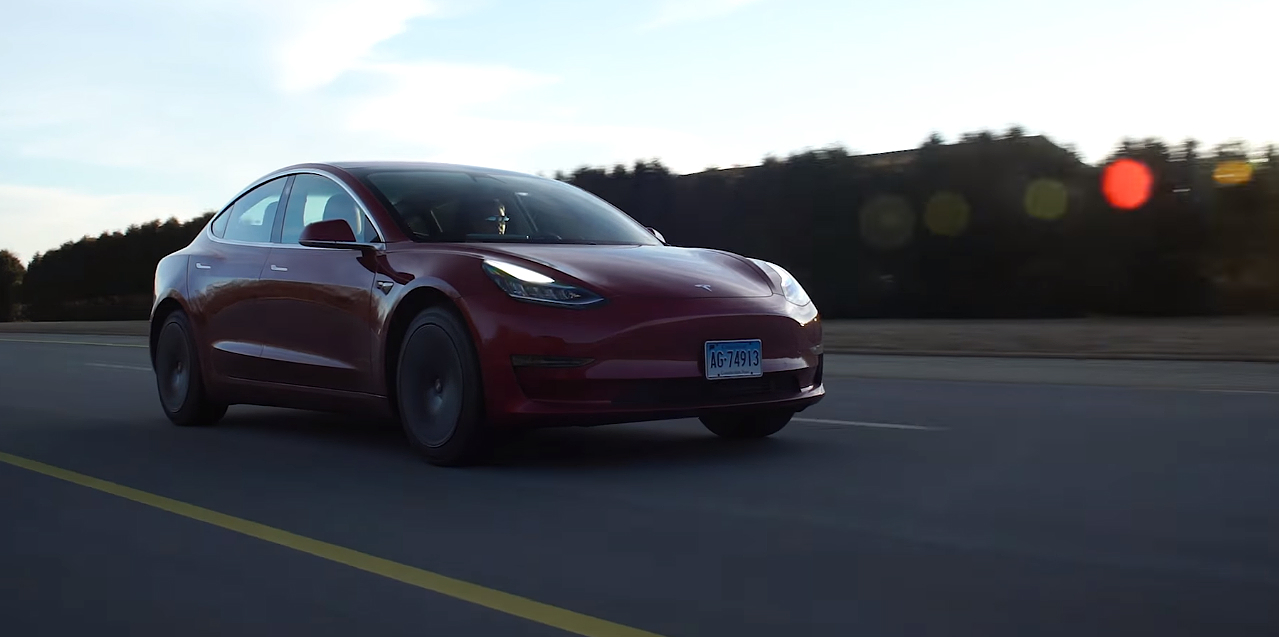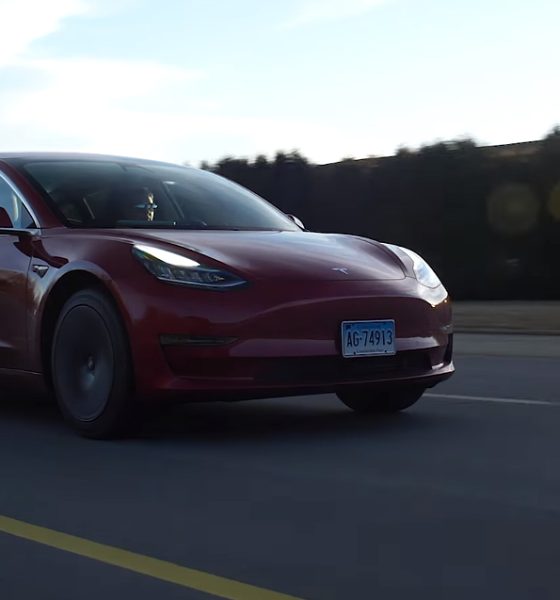

News
Tesla Model 3 gets CR recommendation after OTA brake update
The Tesla Model 3 has managed to earn a “Recommended” rating from Consumer Reports after a recent firmware update improved the vehicle’s braking distance by nearly 20 feet.
In a recently published update on its official website, Consumer Reports confirmed that its new test results for the Model 3 revealed that Tesla had reduced the braking distance of the compact electric car by nearly 20 feet through a recent OTA update. During the magazine’s retest of the vehicle, the Model 3 managed to hit a full stop from 60 mph in 133 feet, a 19-foot, or roughly 13%, improvement over its previous braking distance of 152 feet.
According to CR, the Model 3’s updated 133-foot braking distance now stands among typical compact luxury cars. The numbers also match Tesla’s own figures. Ultimately, the Model 3 firmware update pushed out this past weekend was enough to raise the compact electric car’s Overall Score enough to warrant a “Recommended” rating.
Consumer Reports Auto Test Director Jake Fisher noted that this is the first time he has seen a carmaker improve a vehicle’s braking system through an OTA software update.
“I’ve been at CR for 19 years and tested more than 1,000 cars, and I’ve never seen a car that could improve its track performance with an over-the-air update,” he said.
Consumer Reports noted in its updated score for the Model 3 that several points of concern still were still evident in the vehicle. Among these are wind noise, a stiff ride, and an uncomfortable rear seat. As we noted in a previous report, some of these were addressed by Elon Musk during a phone conversation with CR’s Jake Fisher.
According to Musk, some of these concerns had been addressed in the Model 3 production line over the past few months. With this in mind, Consumer Reports stated in its updated results that it would be renting another vehicle to validate Musk’s statements about the more recent improvements to the Model 3. Nevertheless, Musk has posted a few tips to improve the Model 3’s wind noise and ride quality.
Braking & UI upgrades apply to all Model 3s. Improved windshield for aero noise & suspension for ride comfort are major ops. Unless you’re really bothered by them, don’t replace. Best way to improve ride is drop tire pressure to ~39 psi. 45 psi is best range, but lower comfort.
— Elon Musk (@elonmusk) May 30, 2018
Also mentioned in CR’s updated Model 3 ratings were the difficulties associated with the car’s 15-inch center-mounted touchscreen, which handles almost all of the vehicle’s controls. Improvements to the touch panel and further automated features for the vehicle were discussed by Musk during his conversation with the CR Auto Test Director. According to the magazine, the recent OTA update already rolled out some changes to the electric car’s controls.
“Now, when drivers adjust their seat position using the power controls along the edge of the driver’s seat, prompts to adjust the car’s mirrors and steering-wheel position appear on the center touch screen. At first glance, these changes seem to be an improvement, but we need to spend more time evaluating them,” CR noted in its updated Model 3 ratings.
Consumer Reports has a mixed relationship with Tesla’s offerings so far, with the magazine dubbing the Model S as the best car it has ever tested. The Model X, however, did not get much approval from CR, with the magazine describing the vehicle as “fast and flawed.”

Elon Musk
Starlink passes 9 million active customers just weeks after hitting 8 million
The milestone highlights the accelerating growth of Starlink, which has now been adding over 20,000 new users per day.

SpaceX’s Starlink satellite internet service has continued its rapid global expansion, surpassing 9 million active customers just weeks after crossing the 8 million mark.
The milestone highlights the accelerating growth of Starlink, which has now been adding over 20,000 new users per day.
9 million customers
In a post on X, SpaceX stated that Starlink now serves over 9 million active users across 155 countries, territories, and markets. The company reached 8 million customers in early November, meaning it added roughly 1 million subscribers in under seven weeks, or about 21,275 new users on average per day.
“Starlink is connecting more than 9M active customers with high-speed internet across 155 countries, territories, and many other markets,” Starlink wrote in a post on its official X account. SpaceX President Gwynne Shotwell also celebrated the milestone on X. “A huge thank you to all of our customers and congrats to the Starlink team for such an incredible product,” she wrote.
That growth rate reflects both rising demand for broadband in underserved regions and Starlink’s expanding satellite constellation, which now includes more than 9,000 low-Earth-orbit satellites designed to deliver high-speed, low-latency internet worldwide.
Starlink’s momentum
Starlink’s momentum has been building up. SpaceX reported 4.6 million Starlink customers in December 2024, followed by 7 million by August 2025, and 8 million customers in November. Independent data also suggests Starlink usage is rising sharply, with Cloudflare reporting that global web traffic from Starlink users more than doubled in 2025, as noted in an Insider report.
Starlink’s momentum is increasingly tied to SpaceX’s broader financial outlook. Elon Musk has said the satellite network is “by far” the company’s largest revenue driver, and reports suggest SpaceX may be positioning itself for an initial public offering as soon as next year, with valuations estimated as high as $1.5 trillion. Musk has also suggested in the past that Starlink could have its own IPO in the future.
News
NVIDIA Director of Robotics: Tesla FSD v14 is the first AI to pass the “Physical Turing Test”
After testing FSD v14, Fan stated that his experience with FSD felt magical at first, but it soon started to feel like a routine.

NVIDIA Director of Robotics Jim Fan has praised Tesla’s Full Self-Driving (Supervised) v14 as the first AI to pass what he described as a “Physical Turing Test.”
After testing FSD v14, Fan stated that his experience with FSD felt magical at first, but it soon started to feel like a routine. And just like smartphones today, removing it now would “actively hurt.”
Jim Fan’s hands-on FSD v14 impressions
Fan, a leading researcher in embodied AI who is currently solving Physical AI at NVIDIA and spearheading the company’s Project GR00T initiative, noted that he actually was late to the Tesla game. He was, however, one of the first to try out FSD v14.
“I was very late to own a Tesla but among the earliest to try out FSD v14. It’s perhaps the first time I experience an AI that passes the Physical Turing Test: after a long day at work, you press a button, lay back, and couldn’t tell if a neural net or a human drove you home,” Fan wrote in a post on X.
Fan added: “Despite knowing exactly how robot learning works, I still find it magical watching the steering wheel turn by itself. First it feels surreal, next it becomes routine. Then, like the smartphone, taking it away actively hurts. This is how humanity gets rewired and glued to god-like technologies.”
The Physical Turing Test
The original Turing Test was conceived by Alan Turing in 1950, and it was aimed at determining if a machine could exhibit behavior that is equivalent to or indistinguishable from a human. By focusing on text-based conversations, the original Turing Test set a high bar for natural language processing and machine learning.
This test has been passed by today’s large language models. However, the capability to converse in a humanlike manner is a completely different challenge from performing real-world problem-solving or physical interactions. Thus, Fan introduced the Physical Turing Test, which challenges AI systems to demonstrate intelligence through physical actions.
Based on Fan’s comments, Tesla has demonstrated these intelligent physical actions with FSD v14. Elon Musk agreed with the NVIDIA executive, stating in a post on X that with FSD v14, “you can sense the sentience maturing.” Musk also praised Tesla AI, calling it the best “real-world AI” today.
News
Tesla AI team burns the Christmas midnight oil by releasing FSD v14.2.2.1
The update was released just a day after FSD v14.2.2 started rolling out to customers.

Tesla is burning the midnight oil this Christmas, with the Tesla AI team quietly rolling out Full Self-Driving (Supervised) v14.2.2.1 just a day after FSD v14.2.2 started rolling out to customers.
Tesla owner shares insights on FSD v14.2.2.1
Longtime Tesla owner and FSD tester @BLKMDL3 shared some insights following several drives with FSD v14.2.2.1 in rainy Los Angeles conditions with standing water and faded lane lines. He reported zero steering hesitation or stutter, confident lane changes, and maneuvers executed with precision that evoked the performance of Tesla’s driverless Robotaxis in Austin.
Parking performance impressed, with most spots nailed perfectly, including tight, sharp turns, in single attempts without shaky steering. One minor offset happened only due to another vehicle that was parked over the line, which FSD accommodated by a few extra inches. In rain that typically erases road markings, FSD visualized lanes and turn lines better than humans, positioning itself flawlessly when entering new streets as well.
“Took it up a dark, wet, and twisty canyon road up and down the hill tonight and it went very well as to be expected. Stayed centered in the lane, kept speed well and gives a confidence inspiring steering feel where it handles these curvy roads better than the majority of human drivers,” the Tesla owner wrote in a post on X.
Tesla’s FSD v14.2.2 update
Just a day before FSD v14.2.2.1’s release, Tesla rolled out FSD v14.2.2, which was focused on smoother real-world performance, better obstacle awareness, and precise end-of-trip routing. According to the update’s release notes, FSD v14.2.2 upgrades the vision encoder neural network with higher resolution features, enhancing detection of emergency vehicles, road obstacles, and human gestures.
New Arrival Options also allowed users to select preferred drop-off styles, such as Parking Lot, Street, Driveway, Parking Garage, or Curbside, with the navigation pin automatically adjusting to the ideal spot. Other refinements include pulling over for emergency vehicles, real-time vision-based detours for blocked roads, improved gate and debris handling, and Speed Profiles for customized driving styles.








